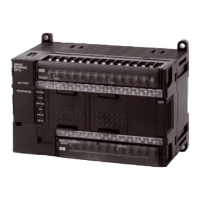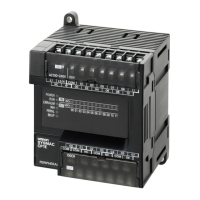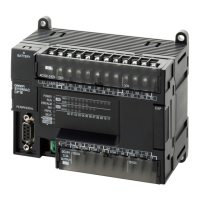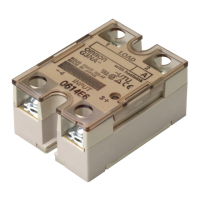397
Memory Cassette Functions Section 6-6
Data that Can be
Stored on a Memory
Cassette
The following data can be stored on a Memory Cassette.
The areas for storing various types of data have fixed allocations in the Mem-
ory Cassette, and a single Memory Cassette corresponds to a single CPU
Unit.
Therefore it is not possible to simultaneously store multiple items of the same
type of data (e.g., two user programs).
Also, the data can only be read to a CPU Unit. It cannot be directly managed
from a personal computer like files.
The only data that can be stored on a Memory Cassette is the data from a
CPU Unit.
Note The CX-Programmer's function for saving DM initial values is used for saving
the values in the DM Area (D0 to D32767) to the built-in flash memory as ini-
tial values. By means of a setting in the PLC Setup, these initial values can
then be automatically written to the DM Area (D0 to D32767) when the power
is turned ON.
6-6-2 Mounting and Removing a Memory Cassette
Mounting
1,2,3...
1. Turn OFF the power supply to the PLC and removed the cover to the Mem-
ory Cassette socket.
Data stored on Memory Cassette Location in CPU Unit
User programs Built-in RAM, built-in flash
memory (User Program Area)
Parameters PLC Setup, CPU Bus Unit set-
tings, routing tables
Built-in RAM, built-in flash
memory (Parameter Area)
Comment data
for user pro-
grams
Variable tables Built-in flash memory (Com-
ment Memory Area)
(I/O comments, rung com-
ments, program comments)
Built-in flash memory (Com-
ment Memory Area)
Program indexes (section
names, section comments,
program comments)
Built-in flash memory (Com-
ment Memory Area)
Function Block (FB) sources Built-in flash memory (FB
Source Memory Area)
DM Built-in RAM (D0 to D32767 in
DM Area)
DM initial values (See note.) Built-in flash memory (DM Ini-
tial Values Area)
CPU Units with 10, 14 or 20 I/O Points
CPU Units with 30, 40 or 60 I/O Points

